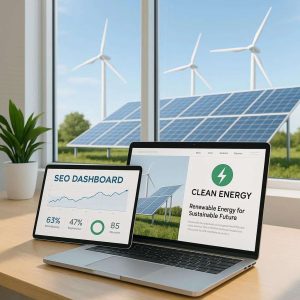Power and Energy in the Digital Age: How Web Design and SEO Drive Industry Growth
 The power and energy industry is no longer just about producing electricity or fuel. It now focuses on smarter, cleaner, and more sustainable systems that can adapt to modern demands. With renewable sources like solar and wind becoming mainstream, energy companies must also evolve digitally. A strong online presence has become essential for customer education, brand trust, and operational transparency.
The power and energy industry is no longer just about producing electricity or fuel. It now focuses on smarter, cleaner, and more sustainable systems that can adapt to modern demands. With renewable sources like solar and wind becoming mainstream, energy companies must also evolve digitally. A strong online presence has become essential for customer education, brand trust, and operational transparency.
People search online for everything—from choosing an energy provider to learning about smart grids or electric vehicle charging. This makes Eschmedia webdesign & SEO critical for energy businesses. The way a company presents itself online influences how customers perceive its innovation, reliability, and commitment to sustainability.
Why Web Design Matters for Energy Companies
A well-designed website serves as the digital face of any energy brand. It’s often the first impression potential clients or investors get. Clean layouts, easy navigation, and informative visuals make it easier for users to find what they need—whether it’s information about power generation, sustainability programs, or billing options.
Web design in the energy sector should focus on clarity and trust. Websites that use eco-inspired color schemes, interactive maps of energy projects, and real-time power usage dashboards instantly create a sense of transparency. The design should also support functionality—allowing users to pay bills, book consultations, or view energy-saving tips easily.
More importantly, responsive design ensures that every feature works seamlessly across mobile devices. Many users check energy information through their phones, especially when comparing rates or looking for local service providers. A mobile-friendly site keeps engagement high and bounce rates low.
SEO as the Backbone of Digital Visibility
Search Engine Optimization (SEO) is what helps energy companies be found online. Even the most stunning website can go unnoticed if it doesn’t appear in search results. SEO ensures that people searching for “solar panel installation,” “energy-saving tips,” or “electricity providers near me” find the company’s site first.
For the power and energy sector, SEO starts with targeted keywords that reflect real-world user needs. This includes both technical and local searches—like “renewable energy solutions Philippines” or “industrial power systems maintenance.” By optimizing for these terms, companies can reach both homeowners looking for sustainability tips and businesses seeking large-scale energy solutions.
Another essential part of SEO is content creation. Blogs, case studies, and whitepapers can explain complex energy topics in simple ways. This not only boosts search rankings but also establishes authority and trust. When customers read informative content, they are more likely to view the company as a reliable energy partner.
Integrating Design and SEO for Maximum Impact
Web design and SEO work best when they complement each other. For example, a fast-loading, mobile-optimized website supports better SEO rankings. Search engines prioritize pages that provide a great user experience, which includes speed, security, and accessibility.
Visual storytelling also helps. Using high-quality images and infographics to explain topics like “how solar power works” or “the journey of electricity from plant to home” can make complex topics easier to understand. However, these visuals should be properly optimized—using descriptive alt text and compressed file sizes—to avoid slowing down the site.
Internal linking and clear page structures are another way web design supports SEO. When site navigation is logical, search engines can crawl and index content more efficiently. For instance, an energy company can group its pages into categories like Renewable Energy, Industrial Services, and Customer Support. This structure helps both users and search engines find information quickly.
Building Trust Through Digital Transparency
The power and energy sector thrives on trust. Customers want assurance that the company they choose is responsible and reliable. Through effective web design, companies can showcase certifications, safety standards, sustainability initiatives, and client testimonials.
SEO, in turn, helps spread this message further. Positive reviews, featured news stories, and strong online visibility show that the company is credible and active. A well-optimized website that ranks high in search results signals reliability and expertise—two key factors for success in this industry.
Regularly updating content also demonstrates accountability. Sharing updates about energy conservation programs or infrastructure improvements can strengthen the brand’s reputation. When people see transparency in communication, they feel more confident engaging with the brand.
